Morocco
Welcome to Morocco
Morocco, located in the northwestern corner of Africa, is a captivating country where vibrant culture, rich history, and diverse landscapes converge to create an unforgettable travel experience. From the bustling medinas and colorful souks of Marrakech and Fez to the serene blue streets of Chefchaouen and the vast Sahara Desert, Morocco offers a sensory feast of sights, sounds, and flavors. Whether you are wandering ancient city streets, hiking the Atlas Mountains, or riding camels across golden dunes, Morocco promises adventure and discovery at every turn.
Morocco is a land of contrasts and diversity. Its geography ranges from Mediterranean and Atlantic coastlines to rugged mountain ranges and expansive deserts. The country is divided into distinct regions, including the Mediterranean coast with its Spanish enclaves, the bustling north Atlantic coast home to Casablanca and Rabat, the scenic south Atlantic coast with beach towns like Essaouira and Agadir, and the mountainous High and Middle Atlas regions where Berber culture thrives. The Sahara Desert in the south offers a dramatic landscape of endless sand dunes and traditional nomadic life. Morocco’s cities blend Islamic architecture, French colonial influences, and indigenous Berber traditions, creating a unique cultural tapestry.
1.
A Feast for the Senses: Morocco’s medinas are alive with vibrant colors, aromatic spices, and the sounds of bustling markets. Exploring the ancient souks, tasting traditional tagines and mint tea, and admiring intricate mosaics and architecture immerse visitors in a rich cultural heritage.

2.
Diverse Landscapes and Experiences: From the snow-capped peaks of the Atlas Mountains to the sun-drenched Sahara Desert, Morocco offers a wide range of outdoor activities such as hiking, camel trekking, and camping under the stars. The country’s historic cities, coastal towns, and Berber villages provide endless opportunities to explore history, art, and local traditions.

Planning Your Trip
Visa Information
Many travelers can enter Morocco visa-free for stays ranging from 30 to 90 days, depending on nationality. Citizens of the United States, Canada, the European Union, Australia, and several other countries do not require a visa for tourism purposes. However, it is essential to check the latest visa requirements before traveling, as policies can change. Your passport should be valid for at least six months beyond your planned departure date. For longer stays or other types of visits, a visa may be required, which can be obtained from Moroccan consulates or embassies abroad.
Best Time to Visit
The ideal time to visit Morocco is during the spring (March to May) and autumn (September to November) when the weather is mild and pleasant across most of the country. Summers can be very hot, especially in the interior and desert regions, with temperatures soaring above 40°C (104°F). Winters are cooler, particularly in the mountainous areas where snow is common. Coastal cities like Casablanca and Essaouira enjoy moderate temperatures year-round. Planning your trip around these seasons ensures comfortable weather for sightseeing and outdoor activities.
Getting To and Around
Getting to Morocco
Morocco is well-connected by air to major cities in Europe, the Middle East, and Africa. The main international airports are in Casablanca (Mohammed V International Airport), Marrakech (Menara Airport), and Rabat (Rabat-Salé Airport). Direct flights from Europe typically take between 2 to 4 hours, making Morocco an accessible destination for a short or extended trip.
Getting Around
Travel within Morocco can be accomplished by a variety of means:
- Trains: Morocco’s train network connects major cities such as Casablanca, Rabat, Marrakech, Fez, and Tangier. Trains are comfortable, affordable, and efficient for intercity travel.
- Buses and Coaches: Extensive bus services cover most towns and rural areas. Companies like CTM and Supratours offer reliable routes.
- Car Rentals: Renting a car provides flexibility to explore remote areas, mountain villages, and desert regions at your own pace. Roads are generally in good condition, but driving in medinas or busy cities requires caution.
- Taxis: In cities, petit taxis are used for short trips, while grand taxis serve longer distances or intercity travel. Always agree on a fare beforehand or ensure the meter is used.
- Domestic Flights: For longer distances, domestic flights connect cities like Casablanca, Marrakech, and Agadir.
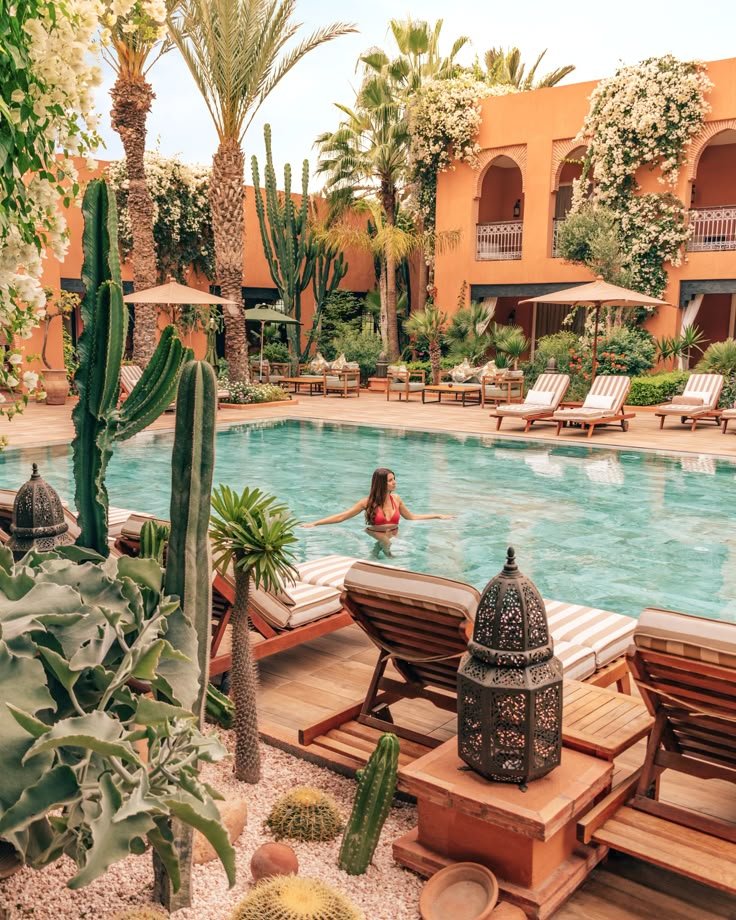
Accommodation
Morocco offers a diverse range of accommodations that cater to every travel style and budget, from luxurious hotels to traditional desert camps. Choosing where to stay is a key part of your Moroccan experience, as it can immerse you in the country’s rich culture or provide modern comforts depending on your preference.
Accommodation Options
- Riads
One of the most iconic types of accommodation in Morocco is the riad. Originally built as grand homes for wealthy families, riads are traditional Moroccan houses featuring a central courtyard or garden, often with a fountain, open to the sky. These buildings typically have rooms arranged around the courtyard, offering privacy and a serene atmosphere away from the bustling medinas. Riads are usually found within the old city walls (medinas) of cities like Marrakech, Fez, and Essaouira. They are beautifully decorated with intricate tilework, carved wood, and lush greenery, combining traditional Moroccan architecture with boutique hotel comforts. Staying in a riad offers an intimate, authentic experience with personalized service, often including home-cooked meals and rooftop terraces with panoramic views. Prices vary widely, making riads accessible to budget and luxury travelers alike. - Hotels
Morocco has a broad spectrum of hotels ranging from budget-friendly to ultra-luxurious five-star resorts. In major cities and tourist hubs such as Casablanca, Marrakech, Agadir, and Tangier, you will find international hotel chains alongside Moroccan-owned establishments. Hotels in the newer parts of cities tend to offer familiar amenities such as air conditioning, swimming pools, fitness centers, and fine dining restaurants. For example, luxury hotels like the Nobu Hotel Marrakech provide spacious suites, rooftop pools, and exceptional concierge services for travelers seeking a high-end stay. Mid-range and budget hotels are plentiful, especially near transport hubs and city centers, offering functional rooms with basic comforts at affordable prices. - Kasbahs and Desert Camps
In southern Morocco, especially near the Sahara Desert, traditional kasbahs—fortified mud-brick homes—have been converted into charming accommodations. These provide a unique cultural experience, often surrounded by dramatic desert landscapes or mountain scenery. For a truly unforgettable night, many travelers opt to stay in Berber desert camps or “haimas,” which are nomadic-style tents set up in the dunes. These camps range from basic setups with shared facilities to luxury tents equipped with private bathrooms and comfortable bedding. Sleeping under the stars in the Sahara, enjoying traditional music and cuisine around a campfire, is a highlight of many Moroccan itineraries. - Guesthouses, Hostels, and Homestays
For budget travelers or those seeking a more social atmosphere, Morocco offers numerous hostels and guesthouses. These tend to be simple but colorful, often with rooftop terraces and communal spaces perfect for meeting other travelers. Homestays, particularly in rural and mountainous regions like the Atlas Mountains, provide an immersive cultural experience where guests can share meals and daily life with local families. These stays are ideal for those wanting to connect deeply with Moroccan traditions and hospitality. - Self-Catering and Apartments
In cities like Marrakech, Agadir, and Tangier, self-catering apartments and guesthouses are available for travelers who prefer the convenience of cooking their own meals or staying longer in one place. These options are often more economical for families or groups and provide a comfortable, home-like environment.
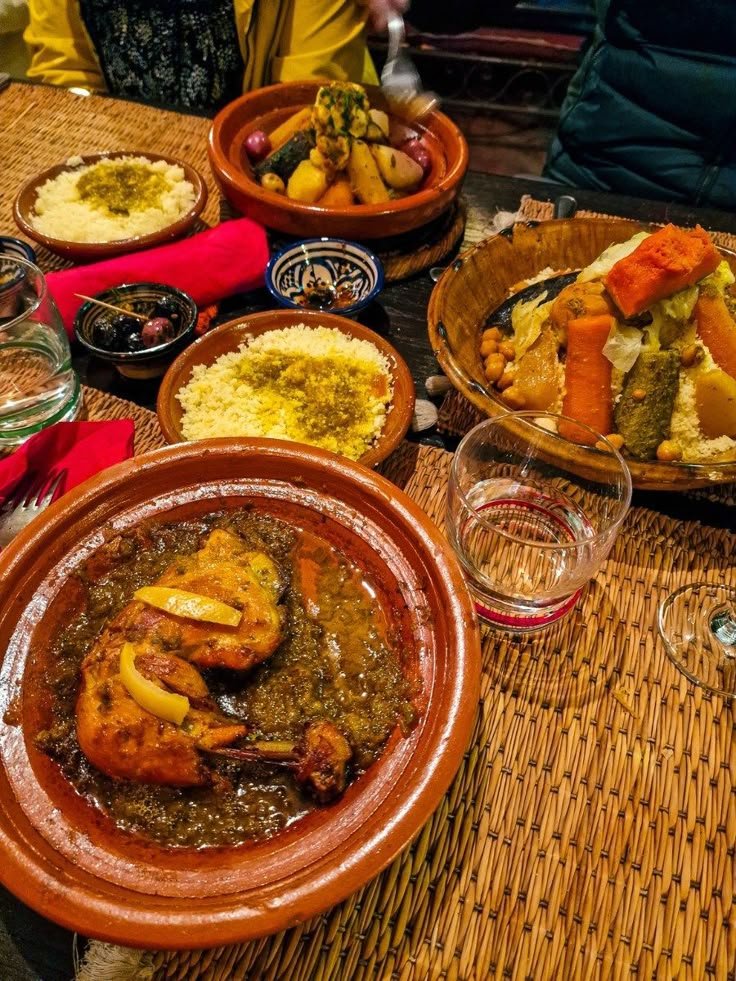
Food and Drink
Moroccan cuisine is a vibrant reflection of the country’s diverse cultural influences, blending Berber, Arab, Mediterranean, and French flavors. Eating in Morocco is a sensory adventure, with aromatic spices, fresh ingredients, and traditional cooking methods creating unforgettable dishes.
- Traditional Moroccan Dishes
- Tagine: Named after the earthenware pot it’s cooked in, tagine is a slow-cooked stew combining meat (often lamb, chicken, or beef), vegetables, dried fruits, and a blend of spices such as saffron, cumin, and cinnamon. Each region has its own variations, and it is often served with bread to soak up the rich sauce.
- Couscous: A staple dish made from steamed semolina grains, usually served with a hearty stew of meat and vegetables. Couscous is traditionally eaten on Fridays and during special occasions.
- Pastilla (Bastilla): A savory-sweet pie made with layers of thin pastry, pigeon or chicken meat, almonds, and a dusting of cinnamon and sugar. It’s a festive dish often enjoyed at weddings and celebrations.
- Harira: A hearty soup made with tomatoes, lentils, chickpeas, and lamb, flavored with herbs and spices. It is especially popular during Ramadan to break the fast.
- Kebabs and Mechoui: Grilled meats seasoned with Moroccan spices, often served with bread or rice.
- Street Food and Snacks
Morocco’s street food scene is lively and affordable. Try freshly baked Msemen(square-shaped flatbread), Briouats(fried pastry filled with meat or cheese), and Sfenj (Moroccan doughnuts). Markets and food stalls offer a variety of olives, nuts, and fresh fruits. - Moroccan Bread
Bread is a central part of every meal. The most common types are Khobz(round, crusty bread) and Batbout(a soft, pita-like bread). Bread is used as a utensil to scoop up food, so meals often come with generous baskets of warm bread. - Drinks
- Mint Tea: Known as “Moroccan whisky,” this sweet green tea with fresh mint leaves is a symbol of hospitality and is served throughout the day. The tea is poured from a height to create a frothy top and enhance the flavor.
- Coffee: While tea is dominant, coffee culture is growing, especially in cities, with cafes offering espresso and traditional Moroccan coffee.
- Fresh Juices: Markets often have stands selling freshly squeezed orange, pomegranate, or lemon juice—refreshing and natural.
- Alcohol: Morocco is a Muslim country, so alcohol is less prevalent but available in many hotels, bars, and some restaurants, especially in tourist areas.
- Dining Etiquette and Tips
Moroccan meals are often communal, with dishes shared from a central plate. It’s customary to eat with the right hand, using bread as a utensil. Hospitality is highly valued, so expect generous servings and invitations to enjoy multiple courses. When dining in traditional settings like riads or local homes, it’s polite to accept at least a small portion of each dish offered.
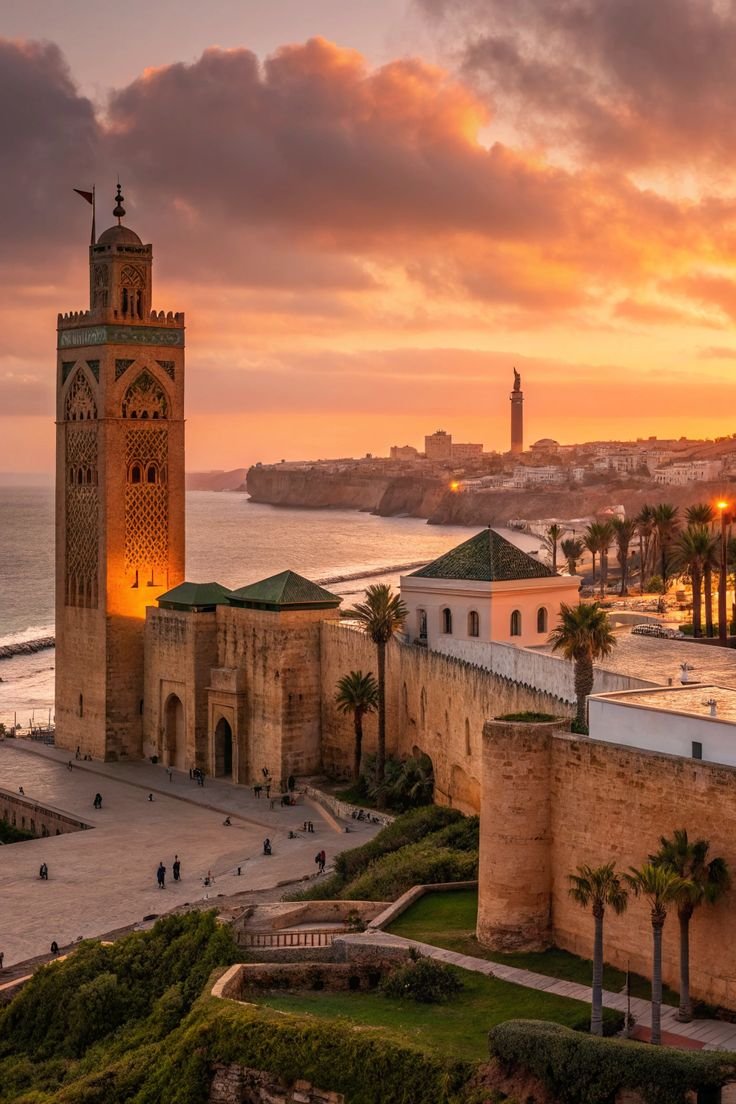
Must-See Attractions
- Marrakech – The Red City
Marrakech is the pulsating heart of Morocco, famous for its lively medina, historic palaces, and colorful souks. The Jemaa el-Fnaa square is a sensory overload, filled with snake charmers, street performers, and food stalls serving traditional Moroccan delicacies. Don’t miss the Bahia Palace, a 19th-century masterpiece with exquisite tilework and tranquil gardens, or the Jardin Majorelle, a stunning botanical garden once owned by Yves Saint Laurent. The Koutoubia Mosque’s minaret dominates the skyline, offering a striking landmark. Marrakech perfectly blends history, culture, and modern luxury, making it a top destination in 2025.
- Fez – Morocco’s Cultural Capital
Fez is a living museum of Moroccan culture and history. Its ancient medina, a UNESCO World Heritage site, is a labyrinth of narrow alleys, bustling markets, and historic madrasas (Islamic schools). Fez is renowned for its traditional crafts, especially ceramics and leather goods, which you can watch being made in the famous tanneries. The city’s spiritual atmosphere and authentic ambiance make it a must-visit for those wanting to experience Morocco’s deep cultural roots.
- Chefchaouen – The Blue Pearl
Nestled in the Rif Mountains, Chefchaouen is famous for its striking blue-painted streets and buildings. This picturesque town offers a peaceful retreat with a relaxed vibe, artisan shops, and beautiful mountain scenery. Wander through its charming alleys, visit the local markets, or hike to the nearby Ras El Maa waterfall for stunning views. Chefchaouen is perfect for photography enthusiasts and travelers seeking tranquility.
- Aït Benhaddou – The Ancient Ksar
Aït Benhaddou is a spectacular fortified village made of red mud bricks, perched on a hilltop between Marrakech and the Sahara Desert. This UNESCO World Heritage site has served as the backdrop for many famous films, including Game of Thrones and Gladiator. Exploring its narrow streets and rooftop views offers a glimpse into Morocco’s historic architecture and desert life. Sunset over the kasbah is a breathtaking experience.
- Sahara Desert – Erg Chebbi Dunes
No trip to Morocco is complete without experiencing the Sahara Desert. The Erg Chebbi dunes near Merzouga offer towering golden sands perfect for camel trekking and overnight camping under the stars. The desert landscape is otherworldly, and spending a night in a Berber tent with traditional music and food is a highlight for many visitors.
- Meknes and Volubilis
Often overshadowed by other imperial cities, Meknes is a charming city with grand gates, palaces, and vibrant souks. Nearby, the Roman ruins of Volubilis offer a fascinating glimpse into Morocco’s ancient past, with well-preserved mosaics and temples set against a scenic backdrop. Meknes’ blend of history and culture makes it a rewarding day trip.
- Essaouira – Coastal Charm
Essaouira is a laid-back coastal town known for its fortified medina, fresh seafood, and Atlantic breezes. Its historic ramparts overlook the ocean, and the town is famous for windsurfing and kite surfing. The medina’s art galleries and cafes create a creative atmosphere, ideal for those seeking a relaxed seaside escape.
- Atlas Mountains
The High Atlas Mountains offer stunning landscapes and outdoor adventures. Trekking through Berber villages, exploring valleys like the Dades and Todra, or visiting the Ourika Valley provides a refreshing contrast to Morocco’s cities. The mountains are perfect for hiking, mountain biking, and immersing yourself in rural Moroccan life.
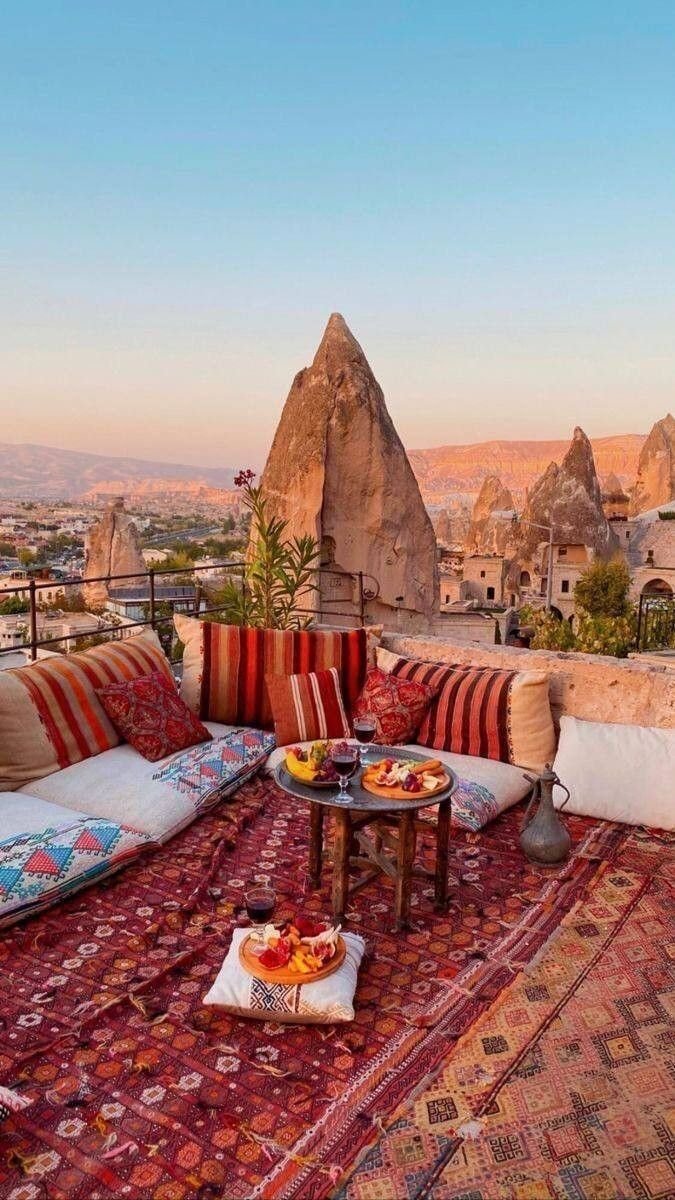
Must-Do Activities
- Explore the Medina Markets
Morocco’s medinas are bustling hubs of commerce and culture. Getting lost in the maze of souks is part of the adventure—browse spices, textiles, ceramics, and jewelry while soaking in the vibrant atmosphere. Bargaining is expected, so hone your negotiation skills and enjoy the lively interactions with local vendors.
- Camel Trekking in the Sahara
Embark on a camel trek across the Erg Chebbi dunes to experience the vastness of the Sahara Desert. This slow-paced journey allows you to appreciate the desert’s silence and beauty. Many tours include an overnight stay in a desert camp where you can enjoy traditional Berber music, food, and stargazing.
- Visit Historic Palaces and Mosques
Morocco’s architectural heritage is rich and varied. Besides Marrakech’s Bahia Palace and Koutoubia Mosque, explore the Royal Palace in Fez, the Kasbah of the Udayas in Rabat, and the Saadian Tombs in Marrakech. These sites showcase intricate tilework, carved wood, and stunning gardens.
- Hike the Atlas Mountains
For outdoor enthusiasts, hiking in the Atlas Mountains is a must. Trails range from easy day hikes to multi-day treks. You can visit traditional Berber villages, enjoy panoramic views, and even climb Mount Toubkal, North Africa’s highest peak. The mountains provide a peaceful escape and a chance to connect with nature and local culture.
- Experience Moroccan Cuisine
Participate in a cooking class to learn how to prepare classic dishes like tagine, couscous, and pastilla. Many riads and cooking schools in cities like Marrakech and Fez offer hands-on experiences. Sampling street food such as msemen (flatbread), briouats (stuffed pastries), and fresh mint tea is also essential.
- Relax in a Hammam
A visit to a traditional Moroccan hammam (public bathhouse) is a rejuvenating cultural experience. Hammams offer steam baths, exfoliating scrubs, and massages, providing relaxation and a glimpse into Moroccan wellness traditions. Many cities have historic hammams open to tourists.
- Attend a Festival or Cultural Event
Morocco hosts numerous festivals throughout the year. The Gnaoua World Music Festival in Essaouira (June) celebrates traditional African and Moroccan music. The Rose Festival in the Dades Valley (May) honors the blooming of roses with music and dance. Timing your visit to coincide with a festival adds a vibrant cultural dimension.
- Surf and Windsurf on the Atlantic Coast
The coastal towns of Taghazout, Essaouira, and Agadir are popular for surfing and windsurfing. Whether you are a beginner or experienced, the Atlantic waves offer excellent conditions. Many surf schools provide lessons and equipment rentals.
- Explore Ancient Roman and Berber Ruins
Beyond Volubilis, Morocco has several archaeological sites worth visiting. The ancient Roman city of Lixus near Larache and the fortified Berber villages scattered in the Atlas Mountains offer fascinating insights into the country’s layered history.
- Take a Hot Air Balloon Ride
For a unique perspective, take a hot air balloon ride over Marrakech or the surrounding plains. Floating above the palm groves and Atlas Mountains at sunrise offers breathtaking views and memorable photo opportunities.
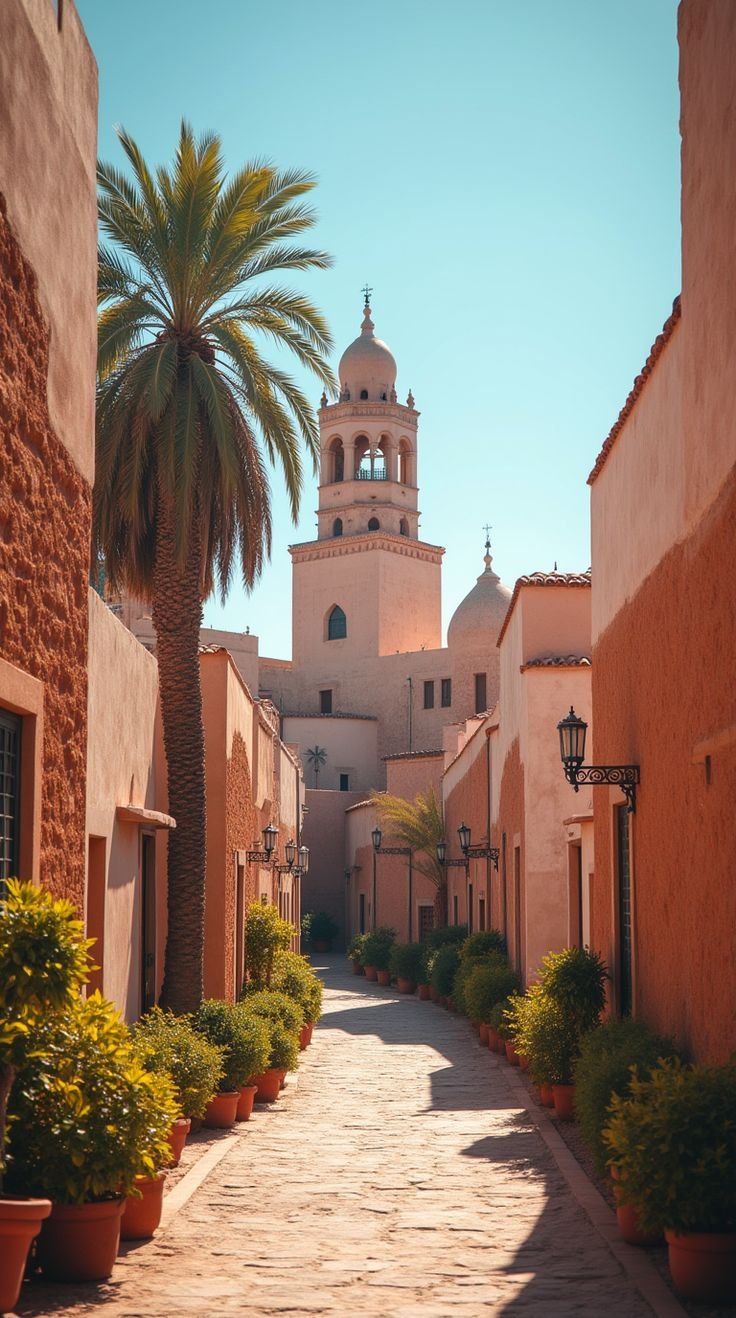
Travel Tips
Traveling to Morocco in 2025 promises an enriching adventure filled with vibrant culture, stunning landscapes, and warm hospitality. To make the most of your trip and ensure a smooth experience, it’s essential to be well-prepared. Here’s a detailed guide covering crucial travel tips on safety, local customs, and language basics that will help you navigate Morocco confidently and respectfully.
Safety Advice
Morocco is generally considered a safe country for tourists, with relatively low rates of violent crime. However, like any popular travel destination, it requires vigilance and common sense to avoid petty crime and other risks.
- Protect Your Belongings
Pickpocketing and petty theft are the most common issues tourists face, especially in crowded places such as medinas, markets, public transportation, and popular tourist sites. Always keep your belongings close and secure. Use anti-theft bags or money belts, avoid flashing expensive jewelry, cameras, or smartphones, and carry only the cash and cards you need for the day. Store extra valuables in your hotel safe.
- Be Aware of Scams and Harassment
Tourists often encounter persistent street vendors, unofficial guides, or overly friendly locals who may try to pressure you into buying goods or services. Politely but firmly decline and keep walking. Be cautious of anyone offering unsolicited help or deals that seem too good to be true. Women traveling alone might experience catcalling or unwanted attention; dressing modestly and maintaining a confident, polite demeanor can reduce such incidents.
- Stay Safe When Moving Around
Avoid poorly lit or isolated areas, especially at night. It’s best to travel with a companion when possible and use reputable transportation. Licensed taxis and official ride-hailing services are safer choices. Driving in Morocco can be challenging due to variable road conditions, aggressive driving styles, and inadequate lighting on rural roads. Avoid driving at night if possible, and always carry your driving documents, including an international driving permit if you plan to rent a car.
- Health and Emergency Contacts
Medical facilities in major cities are generally adequate, but rural areas may have limited resources. Bring any necessary medications and travel insurance that covers medical emergencies. In case of emergency, dial 190 for police or ambulance services. It’s also wise to register with your country’s embassy or consulate upon arrival.
- Terrorism and Political Stability
While Morocco has experienced isolated terrorist incidents in the past, these are rare and not typically targeted at tourists. The government maintains a strong security presence, particularly in tourist areas. Avoid political demonstrations and large gatherings, and stay informed about local news and official advice during your stay.
Local Customs
Morocco’s culture is deeply rooted in Islamic traditions and Berber heritage, with a strong emphasis on hospitality and respect. Observing local customs not only enriches your experience but also helps you avoid misunderstandings.
- Dress Modestly
Morocco is a conservative society, especially outside major cities and tourist resorts. Both men and women should dress modestly—covering shoulders, chest, and knees is advisable. Women may choose loose-fitting clothes and a scarf to cover their hair when visiting religious sites. Modest dress shows respect and can help reduce unwanted attention.
- Greetings and Social Etiquette
Greetings are important in Moroccan culture. A common greeting is “Salam Alaikum” (Peace be upon you), to which the reply is “Wa Alaikum Salam” (And upon you be peace). Handshakes are typical among men; however, physical contact between unrelated men and women is generally avoided. When invited to a Moroccan home, it’s polite to bring a small gift such as sweets or pastries.
- Eating Customs
Moroccans often eat communally, sharing food from a central dish using bread instead of utensils. Use your right hand for eating and passing food, as the left hand is considered unclean. It’s customary to wash your hands before and after meals. When offered tea or food, it’s polite to accept at least a small portion.
- Religion and Ramadan
Islam is the dominant religion, and religious practices influence daily life. During the holy month of Ramadan, Muslims fast from dawn to sunset. Tourists should be respectful by avoiding eating, drinking, or smoking in public during daylight hours. Many restaurants may be closed or have limited hours during Ramadan, but tourist areas often remain open.
- Photography Etiquette
Always ask permission before photographing people, especially women and religious sites. Some locals may be uncomfortable with cameras, and it’s respectful to honor their wishes.
Language Basics
Morocco is a multilingual country, with Arabic and Berber (Amazigh) as official languages, and French widely used in business, government, and education. English is increasingly spoken in tourist areas but less so in rural regions.
Key Phrases in Moroccan Arabic (Darija)
Learning a few basic phrases in Darija will enhance your interactions and show respect for local culture.
- Salam Alaikum – Hello (Peace be upon you)
- Shukran – Thank you
- La shukran – No, thank you
- Bslama – Goodbye
- Afak – Please
- Kam thaman had shi? – How much does this cost?
- Ana min… – I am from…
- Ma fahmtsh – I don’t understand
- Fin kayn…? – Where is…?
- Mzyan – Good
- La – No
- Naam – Yes
French Phrases
Since French is widely spoken, especially in cities and tourist centers, knowing some basic French can be very helpful.
- Bonjour – Good morning/Hello
- Merci – Thank you
- S’il vous plaît – Please
- Où est…? – Where is…?
- Combien ça coûte? – How much does it cost?
- Je ne comprends pas – I don’t understand
Communication Tips
- Speak slowly and clearly.
- Use gestures and smiles to aid understanding.
- Download translation apps for offline use.
- Carry a phrasebook or have key phrases written down.
Final Tips for a Smooth Journey
Morocco offers a fascinating blend of history, culture, and natural beauty, but travelers should approach the country with awareness and respect. Prioritize your safety by protecting your belongings, avoiding risky areas at night, and using trusted transportation. Embrace local customs by dressing modestly, practicing polite greetings, and respecting religious traditions. Learning basic phrases in Moroccan Arabic and French will enrich your experience and open doors to meaningful connections with locals.
By following these travel tips, you will not only stay safe but also gain a deeper appreciation for Morocco’s unique culture and warm hospitality, making your 2025 journey both enjoyable and memorable.

